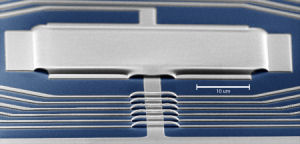16 May 2014
Researchers go beyond quantum limit
by Will Parker
 Scientists are capable of measuring the position of an object with unprecedented accuracy, but the Heisenberg uncertainty principle ultimately places a fundamental limit on such measurements (known as the standard quantum limit). Now, however, Caltech researchers have found a way to filter this quantum background "noise" and make measurements that go beyond the limits imposed by quantum physics.
Scientists are capable of measuring the position of an object with unprecedented accuracy, but the Heisenberg uncertainty principle ultimately places a fundamental limit on such measurements (known as the standard quantum limit). Now, however, Caltech researchers have found a way to filter this quantum background "noise" and make measurements that go beyond the limits imposed by quantum physics.
"If you want to know where something is, you have to scatter something off of it," explains physicist Keith Schwab, who led the study. "For example, if you shine light at an object, the photons that scatter off provide information about the object. But the photons don't all hit and scatter at the same time, and the random pattern of scattering creates quantum fluctuations" - that is, noise. If you shine more light, you have increased sensitivity, but you also have more noise. Here we were looking for a way to beat the uncertainty principle - to increase sensitivity but not noise."
Schwab began by developing a way to actually detect the noise produced during the scattering of microwaves. To do this, Schwab's team delivered microwaves of a specific frequency to a superconducting electronic circuit that vibrates at 5 gigahertz (5 billion times per second). The electronic circuit was then coupled to a mechanical device formed of two metal plates that vibrate at around 4 megahertz. The researchers observed that the quantum noise of the microwave field, due to the impact of individual photons, made the mechanical device (pictured) shake randomly with an amplitude of 10
"Our mechanical device is a tiny square of aluminum - only 40 microns long, or about the diameter of a hair. We think of quantum mechanics as a good description for the behaviors of atoms and electrons and protons and all of that, but normally you don't think of these sorts of quantum effects manifesting themselves on somewhat macroscopic objects," Schwab says. "This is a physical manifestation of the uncertainty principle, seen in single photons impacting a somewhat macroscopic thing."
Once the researchers had a reliable mechanism for detecting the forces generated by the quantum fluctuations of microwaves on a macroscopic object, they could modify their electronic resonator, mechanical device, and mathematical approach to exclude the noise of the position and motion of the vibrating metal plates from their measurement. "It's a way of tricking the uncertainty principle so that you can dial up the sensitivity of a detector without increasing the noise," Schwab explained.
Although this experiment is mostly a fundamental exploration of the quantum nature of microwaves in mechanical devices, Schwab says that this line of research could one day lead to the observation of quantum mechanical effects in much larger mechanical structures. And that, he notes, could allow the demonstration of strange quantum mechanical properties like superposition and entanglement in large objects - for example, allowing a macroscopic object to exist in two places at once.
"Subatomic particles act in quantum ways - they have a wave-like nature - and so can atoms, and so can whole molecules since they're collections of atoms," Schwab says. "So the question then is: Can you make bigger and bigger objects behave in these weird wave-like ways?"
Related:
Discuss this article in our forum
Quasars at opposite ends of the Universe could close a loophole in quantum mechanics
Recent discovery of quantum vibrations in brain neurons lends weight to his controversial theory of consciousness, says Sir Roger Penrose
Entangled quarks hint at reconciliation of quantum mechanics and general relativity
New uncertainty over uncertainty principle
Source: Caltech
